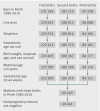Re-evaluation of link between interpregnancy interval and adverse birth outcomes: retrospective cohort study matching two intervals per mother
- PMID: 25056260
- PMCID: PMC4137882
- DOI: 10.1136/bmj.g4333
Re-evaluation of link between interpregnancy interval and adverse birth outcomes: retrospective cohort study matching two intervals per mother
Abstract
Objective: To re-evaluate the causal effect of interpregnancy interval on adverse birth outcomes, on the basis that previous studies relying on between mother comparisons may have inadequately adjusted for confounding by maternal risk factors.
Design: Retrospective cohort study using conditional logistic regression (matching two intervals per mother so each mother acts as her own control) to model the incidence of adverse birth outcomes as a function of interpregnancy interval; additional unconditional logistic regression with adjustment for confounders enabled comparison with the unmatched design of previous studies.
Setting: Perth, Western Australia, 1980-2010.
Participants: 40 441 mothers who each delivered three liveborn singleton neonates.
Main outcome measures: Preterm birth (<37 weeks), small for gestational age birth (<10th centile of birth weight by sex and gestational age), and low birth weight (<2500 g).
Results: Within mother analysis of interpregnancy intervals indicated a much weaker effect of short intervals on the odds of preterm birth and low birth weight compared with estimates generated using a traditional between mother analysis. The traditional unmatched design estimated an adjusted odds ratio for an interpregnancy interval of 0-5 months (relative to the reference category of 18-23 months) of 1.41 (95% confidence interval 1.31 to 1.51) for preterm birth, 1.26 (1.15 to 1.37) for low birth weight, and 0.98 (0.92 to 1.06) for small for gestational age birth. In comparison, the matched design showed a much weaker effect of short interpregnancy interval on preterm birth (odds ratio 1.07, 0.86 to 1.34) and low birth weight (1.03, 0.79 to 1.34), and the effect for small for gestational age birth remained small (1.08, 0.87 to 1.34). Both the unmatched and matched models estimated a high odds of small for gestational age birth and low birth weight for long interpregnancy intervals (longer than 59 months), but the estimated effect of long interpregnancy intervals on the odds of preterm birth was much weaker in the matched model than in the unmatched model.
Conclusion: This study questions the causal effect of short interpregnancy intervals on adverse birth outcomes and points to the possibility of unmeasured or inadequately specified maternal factors in previous studies.
© Ball et al 2014.
Conflict of interest statement
Competing interests: All authors have completed the ICMJE uniform disclosure form at
Comment in
-
Spacing babies.BMJ. 2014 Jul 23;349:g4717. doi: 10.1136/bmj.g4717. BMJ. 2014. PMID: 25056261 No abstract available.
-
Interpregnancy interval and preterm birth: correlation versus causation debate continued.BJOG. 2016 Nov;123(12):2018. doi: 10.1111/1471-0528.14168. Epub 2016 Jul 13. BJOG. 2016. PMID: 27405821 No abstract available.
References
-
- Conde-Agudelo A, Rosas-Bermudez A, Kafury-Goeta AC. Birth spacing and risk of adverse perinatal outcomes: a meta-analysis. JAMA 2006;295:1809-23. - PubMed
-
- Zhu BP. Effect of interpregnancy interval on birth outcomes: findings from three recent US studies. Int J Gynecol Obstet 2005;89:S25-33. - PubMed
-
- Shachar BZ, Lyell DJ. Interpregnancy interval and obstetrical complications. Obstet Gynecol Surv 2012;67:584-96. - PubMed
-
- Grisaru-Granovsky S, Gordon E-S, Haklai Z, Samueloff A, Schimmel MM. Effect of interpregnancy interval on adverse perinatal outcomes: a national study. Contraception 2009;80:512-8. - PubMed
-
- Conde-Agudelo A, Belizan JM, Norton MH, Rosas-Bermudez A. Effect of the interpregnancy interval on perinatal outcomes in Latin America. Obstet Gynecol 2005;106:359-66. - PubMed
Publication types
MeSH terms
LinkOut - more resources
Full Text Sources
Other Literature Sources
Medical

